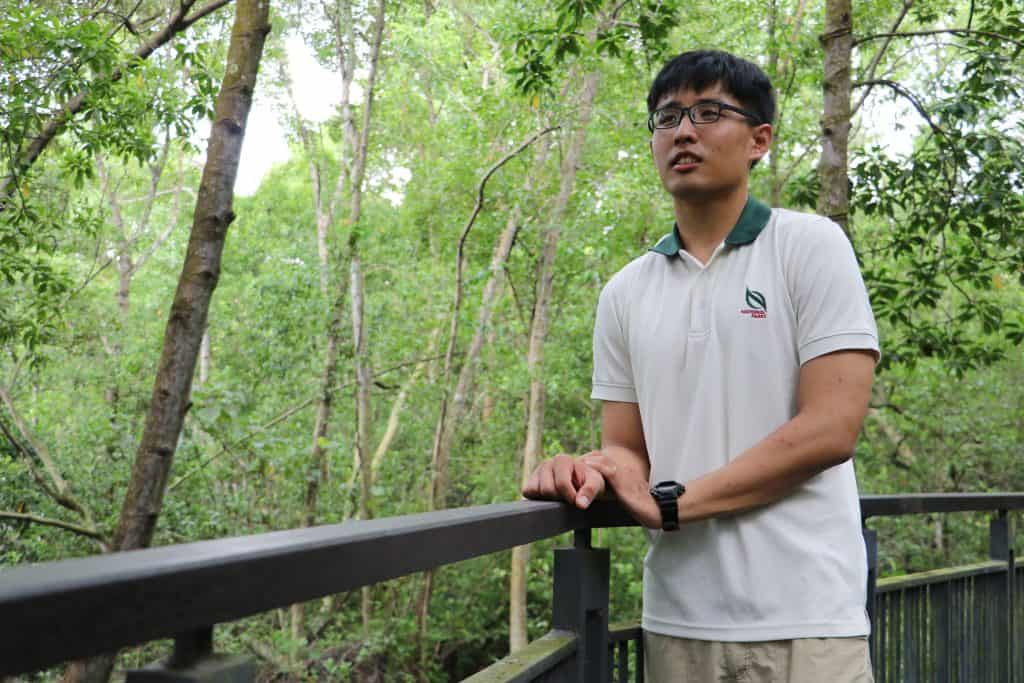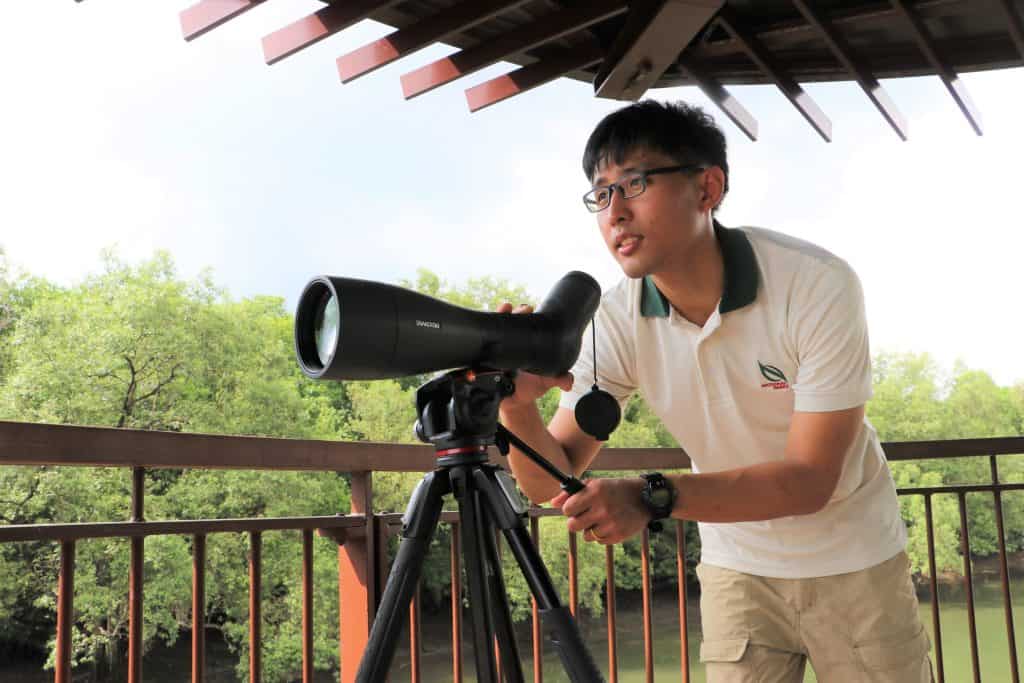While NParks Scholar Jonathan Tan may have travelled the world and even to far-flung exotic locations to study and train to become a well-rounded ecologist, the biodiversity in Singapore’s urban jungle never ceases to fascinate him. Jonathan is committed to safeguarding Singapore’s biodiversity and building its resilience to the effects of climate change. Follow his journey and explore nature stewardship through the lenses of a passionate home-grown conservationist.
A Vision to Promote Harmonious Living with Nature
I have always had a strong interest in the natural world. Growing up, I would watch wildlife documentaries with my grandfather and father. Visiting the Singapore Zoo and Underwater World and indulging in their weird and wonderful diversity was one of my favourite activities as a kid. But in my mind, wildlife was something to be found outside of Singapore, to be seen only on overseas holidays where one could snorkel or birdwatch. Monkeys, mudskippers, and monitor lizards aside, I barely saw any wildlife in Singapore in my childhood years and thought the only option for a career in conservation was to work at my favourite place: the zoo!
All that changed after a school field trip to Pulau Semakau, where I saw first-hand the amazing variety of marine life in our waters. As the tide went out, we explored lush seagrass meadows and craggy coral reefs, finding flamboyant flatworms, serene seahorses, and sea stars bigger than our faces. I never knew that Singapore had so many wonderful marine critters visible to us without having to swim or dive! So began my journey down the rabbit hole (or perhaps otter holt) of exploring biodiversity in Singapore. Over the next few years, I joined several citizen science programmes and nature guiding groups (some of which were with NParks), visiting our beaches and learning as much as I could. New friends and mentors further expanded my horizons, introducing me to the wonders of our tropical rainforests and mangrove swamps.
What struck me most during this time was how marine habitats have found ways to thrive within Singapore’s heavily urbanised landscape. Mangroves sprout from rock revetments, seagrasses flourish along reclaimed beaches, and corals build new homes on seawalls. One of my mentors pointed out that if we could learn from these sites where unplanned regeneration had happened, we could develop a City in Nature where marine biodiversity could thrive in the environment for all to enjoy.
Today, Singapore is special amongst the world’s cities in being a City in Nature, with rainforests, mangroves, and coral reefs easily accessible within half an hour’s drive of our city centre. Sightings of charismatic megafauna are common, with wild boars, otters, crocodiles, and sea turtles calling our islands home. But there is still much to do to promote harmonious living with nature. It was this that made me decide to join the National Parks Board (NParks) on a scholarship.
A World’s View of Biodiversity
I spent three years in London for my studies: a cosmopolitan, multicultural city blessed with a variety of parks and an unexpected assemblage of wildlife (including foxes, newts, and deer!). The United Kingdom (UK) also has a long history of intense industrialisation and deforestation while sustaining a rich tradition of appreciation of the natural world (think Darwin, Wallace, Raffles, Attenborough, and the Royal Society for the Protection of Birds—the latter has more paid members than all the UK political parties put together!).
Taken all together, this meant London, including the wider UK, had certain qualities I had hoped Singapore could also adopt, such as stewarding and celebrating what remains of our biodiversity despite the habitat loss of the past. I was thus particularly interested to learn about their ecological research methods, environmental management, and community involvement. Some of these were covered in my school lectures. But I also picked them up through my trips to hike and wildlife-watch in their many national parks, volunteering with the reptile curator of the Natural History Museum (NHM), and helping a local reptile conservation group with habitat restoration for rare species.
Not unlike London, the faculty at my school, Imperial College, was highly international and had strong ties to globally important biodiversity research institutes such as the NHM and Kew Gardens. With their extensive personal experience in research and environmental management from places as far-flung as Brazil, Lord Howe Island in Australia, Uganda, and New Zealand, I was able to learn from case studies and examples from a wide variety of contexts, greatly enriching my understanding of how different countries have tackled environmental issues. Besides local fieldwork in the UK, I also had the chance to visit the fynbos of South Africa—floristically the most unique place on earth—on a field course and learn about the fire-driven ecology of the habitat and how that shaped land management practices.
The one thing I treasured about the NParks scholarship was that it allowed me to apply for funding to join field expeditions as a research assistant. Through these opportunities, I was able to gain exposure to a wide variety of survey methods, observe local conservation practices (e.g., in land management and community stewardship), and learn new skills (e.g., my Advanced Diver certification that came in useful for my work later). It was also an invaluable chance to experience a wide variety of ecosystem types in various countries: Peru (riverine rainforest), Madagascar (tropical dry forest and coral reef), and the US (temperate grassland).
I also took the chance to extend my travels to visit nearby national parks to observe other ecosystems, such as tropical oceanic islands, montane rainforests, savannahs, chaparral, conifer forests, kelp forests, and deserts. While many of these habitats are not found in Singapore, the breadth of exposure contributed greatly to my professional development as a well-rounded ecologist.

Working Towards a Dream @ NParks
My first posting was at the Coastal and Marine branch of the National Biodiversity Centre (NBC). There, I helped advise other government agencies and divisions within NParks on issues relating to managing of our rich marine ecosystems. These included conservation planning, integrating biodiversity into urban masterplans, mitigation of development impacts, environmental impact assessments, climate change adaptation, and nature-based recreation.
The work was very fulfilling, as it led to tangible outcomes in safeguarding Singapore’s biodiversity for future generations while meeting the needs of our country. It was also a dream coming true, as I could see the future I had hoped for—a Singapore that values the thriving biodiversity along her urban coastline—starting to take shape. As this often involved talking to stakeholders, both within and outside government agencies (such as academics and NGOs), I had the chance to build relationships with like-minded individuals and share a strong sense of purpose and camaraderie.
At NBC, I also took part in fieldwork and research. For instance, I organised and coordinated the Southern Islands Biodiversity Survey to visit more than ten different islands to document their flora and fauna and co-authored a paper mapping out how coastal habitats in Singapore have regenerated over the past three decades. I was also involved in species recovery programmes for endangered species such as the Hawksbill Turtle and Neptune’s Cup sponge and coral restoration. This broadened and deepened my first-hand understanding of marine habitats and biodiversity in Singapore, enabling me to better carry out my role as a technical expert.
Education and outreach were another major part of my work, as we employed every means to raise awareness of the importance of our native biodiversity, such as by conducting guided walks, organising outreach events, and engaging the media. These experiences taught me to better empathise and build relationships with different types of stakeholders, without whom the City in Nature vision cannot be achieved. Some of these were also tied to my involvement in the operations and management of the Sisters’ Islands Marine Park, which gave me a taste of what operations life was like.
Managing the Sungei Buloh Wetland Reserve
My experience in policy and operations during my time with NBC has come in handy for my current posting at Sungei Buloh Wetland Reserve, which manages our only mangrove nature reserve and other sites under the Sungei Buloh Nature Park Network. Here, I am involved in day-to-day park and visitor management as we seek to ensure that the public can enjoy the reserve in a manner safe for themselves and the wildlife. Sungei Buloh Wetland Reserve also carries out its own long-term research. For instance, as a key migratory shorebird site on the East Asian-Australasian Flyway, we regularly conduct bird census and ringing surveys to track their population trends and better understand their migration patterns.
I continue to work on biodiversity policy and planning issues, but specific to the areas I currently manage, such as helping to conceptualise and implement coastal nature-based solutions that tap on natural ecosystems like mangroves to build resilience to the effects of climate change. I am also a part of the secretariat for the Marine Climate Change Science programme, coordinating our efforts to fund research that seeks to keep our marine biodiversity resilient. They are important for their ecosystem services, which help mitigate the effects of climate change.
Love for Nature & Singapore
The decision to commit to a scholarship and career at NParks is not a trivial one. To enjoy and find meaning in one’s work here requires a genuine commitment to and passion for two things: nature and Singapore.
The first needs no further elaboration, but the second is critical. As Singapore is a small country, it is easy to conclude that the impact of biodiversity conservation and nature stewardship here is limited. Many countries have far larger expanses of natural habitat, face more critical social and environmental problems, and are in greater need of help. In the end, it is my love for Singapore that drives me.
If you love these two things, want to take ownership of what you love, and believe in the vision of Singapore as a City in Nature and a role model for other cities around the world, then come join the NParks family!
TAN YONG HOW JONATHAN
NParks Undergraduate Scholarship
Bachelor of Science with First Class Honours in Ecology and Environmental Biology, Imperial College London, United Kingdom
Now: Manager, Conservation
From: NUS High School of Mathematics and Science

